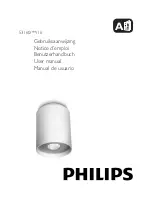
If the lamp is functional, the battery tests properly, the switch is operational and the charging
system is working, but the flashlight fails to operate or the LED fails to light there may be a
problem with the circuit board inside the flashlight.
1. Disconnect the S-40 from any charging source.
2. Remove the battery and rear cover as described in the battery section.
3. Disassemble the flashlight as described in the testing/replacing the switch (step 5).
4. Perform a visual inspection of the circuit board.
a. Look for broken or pinched wires.
b. Look for broken connections where the wires are soldered to the board.
5. Test the components of the circuit board.
A . The 5 ohm, 5 watt resistor is located near the center of the board (see illustration).
1. Check the resistor to see if it is open.
a. Use a multimeter set to the lowest ohms position.
1. Place the black lead on either one of the resistor leads.
2. Place the red lead on the other resistor lead.
3. The meter should read close to zero (approx. 5 ohms).
4. If the meter indicates an “open” condition the resistor will need to be
replaced.
b. If a multimeter is not available a jumper wire can be placed across the resistor
leads.
- 28 –
1. Apply charge power to the flashlight .
2. If the charge indicating LED on the flashlight lights the resistor is bad and
needs to be replaced.
2. To replace the resistor desolder it from the mounting pads on the rear of the
circuit board.
a. Make sure that the mounting holes are free of debris.
b. Bend the leads of the replacement resistor so that they are aligned with the
mounting holes on the circuit board.
c. Solder the new resistor in place.
d. Test the resistor as described in step A 1 above.
B. The 3 pin voltage regulator is marked “7905”.
1. Apply charge power to the flashlight.




































